PV Monitoring System for a Water Pumping Scheme with a Lithium-Ion Battery Using Free Open-Source Software and IoT Technologies
Abstract
1. Introduction
- Facilitating the communication, control, and automation of PV plants [20];
- Establishing references for expected performances in a given region [22];
- Establishing PV behavior and obtaining derating ratios across the plant [23];
- Facilitating other important features such as R&D projects, reporting, system configuration updates, data analysis, and training activities [23].
- Environment: irradiance on the PV plane (GI) and ambient temperature (Tamb)
- PV field: cell temperature (Tcell), voltage (VPV), current (IPV), power (PPV), and energy (EPV)
- Power converter unit: output voltage (VPCU_out), output current (IPCU_out), output power (PPCU_out), and output energy (EPCU_out), with the input variables corresponding to the values defined in the PV field
- Hydraulic circuit: flow rate (Q); water temperature (Tw); and pressure, measured as meter of water column (mwc) and denoted as TDH or total dynamic head
2. Description of the PVWPS+LIB Facility
2.1. System Installed on the Building Rooftop
- DC protections: disconnector, fuses, and surge discharger
- AC power connection at 230 V and 50 Hz for the electronic circuits
- An anemometer (wind speed or ws, measured in km/h) and vane (wind direction, measured in degrees), placed 2 m above the PV array and integrated into the Davis 7911 model. The 4−20 mA outputs are connected to an ADAM 4017+ for transmission through a wired RS485 communication protocol. Minimum accuracy in the current measurements is equal to ± 0.2% [45].
- An Eos Array PV monitoring system from Carlo Gavazzi [46] is used; the solution includes the following:
- ○
- Measurement of voltage and current of the PV string (VPV and IPV) with a VMU-S unit. Current range reaches up to 16 A (for 40 °C), with a maximum DC voltage of 1000 V. For both variables, the accuracy is ± (0.5% RDG + 2 DGT). The PV power and energy are calculated by the VMU-S unit with an accuracy equal to ± (1% RDG + 2 DGT) for the power and ± (1% RDG) for the energy.
- ○
- Cell temperature (model TEMPSOL1000) and ambient temperature (model IKE20001K) by means of a Pt1000 RTD connected to a VMU-P unit (1000 Ω @ 0 °C). The tolerance ranges from ±0.3 °C at 0 °C to ±0.8 °C at 100 °C according to EN60751.
- ○
- Irradiance sensor on the plane of the PV field, measured with a CELLSOL 200 connected to the VMU-P unit. The sensor range is from 0 to 1500 W/m2, with an accuracy of ±5% as an annual average. The sensor presents a linear variation in this range, with a scaling factor of 79.6 mV for 1000 W/m2 provided by the manufacturer after the calibration of the sensor.
- ○
- A VMU-M unit that performs the local bus management of the measuring units (VMU-S and VMU-P) operates as a data logger and communicates data in response to server polls via a Modbus-RTU protocol over an RS485 bus.
2.2. System Installed in the Hydraulics Laboratory
- An electrical panel that establishes the connection between the PV system arranged on the roof of the building and the other system components, including a connection to the electrical power network (Figure 4(a2)). The electrical panel also includes a UWP 3.0 unit that monitors the devices connected to the RS485 local bus via a Modbus-RTU protocol [47].
- A GW3648D-ES hybrid grid-connected inverter from Goodwe, with a rated apparent power of 3680 VA in the two AC outputs (on-grid output and backup output) and up to 5520 VA for 10 s in the backup AC output (Figure 4(a1)) [48]. Data provided by the inverter through the Modbus have the following resolutions: 0.1 V, 0.1 A, 1 W, 0.1 kWh, 0.01 Hz, 0.1 °C, 1% for all percentual values (SOC, PF, etc.).
- A PVWPS controller, model ESP-2.2/230-IP20-F200, supplied by Atersa and which includes a Fuji Electric variable speed driver (Frenic-ACE model FRN0008E2E-7GA), as well as the control and protection circuits necessary to implement a PVWPS (Figure 4(a3)) [50]. This system supports two different power sources: a DC input from a PV field, or a 230 V and 50 Hz single-phase AC input from a conventional electrical grid or auxiliary group. Data provided by the variable speed drive (VSD) through the Modbus have the following resolutions: 1 V, 0.01 A, 0.01 Hz, 1 °C, 0.01% for all percentual values (load factor, input power respect to nominal motor output, etc.).
- An electrical panel (Figure 4(b7)) with the elements for the acquisition of the signals provided by the sensors of the hydraulic system: flow rate (Figure 4(b5)), pressure (Figure 4(b6,b9)), and temperature (in the water tank). All the sensors provide a 4–20 mA analog output signal connected to the second ADAM 4017+, which is connected to the RS485 bus.
2.3. Operating Modes of the PV Facility
- Direct PVWPS (DPVWPS): The PV field is connected to the DC input of the variable speed drive (VSD). The battery and the hybrid inverter are not used in this configuration.
- Stand-alone PV system with lithium battery storage: The PV field is connected to the PV input of the GW3648D-ES hybrid inverter. The inverter is configured to work in off-grid mode (isolated network installation), and the power of the PV field is used to power the AC loads connected to the backup output and to recharge the battery. The inverter manages the operating point of the PV field to balance energy consumption and generation. It may be the case that the PV field does not generate energy if there are no loads connected and the battery is charged. A PVWPS+LIB system is implemented when the AC input of the VSD is connected to the backup output of the hybrid inverter.
- Grid-connected system for self-consumption with lithium battery storage: This system is very similar to the previous one, but the AC-grid output of the hybrid inverter is connected to the AC power network of the lab, and therefore the PV field will always work at the maximum power point (MPP). The excess energy not used by the loads, or by the battery, is injected into the grid. In this case, the VSD that controls the submersible pump is connected to the backup output of the GW3648D-ES hybrid inverter, as well as other critical loads that may exist in the installation.
- An EM21072 network analyzer [52]. The meter uses a Hall effect current sensor in the AC current transformer (model CTD1X605A [53]) and is connected to measure the electrical parameters in the AC supply (point of connection of the PV system with the grid): RMS voltage, active power, reactive power, etc.
- A temperature sensor Thermophant T TTR35 for measuring water temperature in pipes (total error ≤ 0.5 K) [55].
- A class 1 T-type thermocouple for measuring water temperature in the tank that contains the submersible pump [56]. The thermocouple is connected to a temperature transmitter that generates a 4–20 mA signal proportional to the temperature (accuracy ± 0.1 °C of temperature measurement after calibrating) [57].
- Pressure transmitters: Several devices with different ranges are used. A CB3010 unit (Figure 4(b9)), with a 0–250 mbar range, is used to measure the reference water level in the tank where the submersible pump is located [58]. A ST18 unit (Figure 4(b7)), with a 0–6 bar range, is used to measure the TDH at the pump outlet [59]. All pressure sensors have an accuracy ≤ 0.5% of the measurement range.
3. Monitoring System of the PVWPS+LIB Facility
3.1. Hardware of the Monitoring System
3.2. Monitoring System Programs
- Data acquisition and storage in the DB.
- GUI management.
- Data exporter.
3.2.1. Data Acquisition and Storage Modelling
3.2.2. Programs for the Data Acquisition and Storage in DB
- data: for parsing the data received from each of the subsystems
- error: for any kind of error in the system, e.g., connection, format, etc.
- loopstop: for finishing the loopState() method
- Frame format: description + address + length + type + gain + parsing + Influx
- Influx database: measurement + tags + tags_values + fields
3.2.3. Graphical User Interface and Data Exporter
- Start and end date for export, divided in two fields: day/month/year; hour:minute
- Name of the database chosen for data export from the different monitoring systems that store data in InfluxDB
- Method of filling when data are unavailable: linear filling, fill with nulls, fill with zeros, none, and previous
- Selection of the fields to include in the file
- Type of file to export: Excel or .csv
4. Discussion on the Experimental Results of the Monitoring System
- Direct PVWPS (DPVWPS)
- Stand-alone PV system with lithium battery storage
- Grid-connected system for self-consumption with lithium battery storage
4.1. Results for the Grid-Connected Mode
4.2. Direct PV Water Pumping System Mode
4.3. PV Water Pumping System with Lithium-Ion Battery Mode
- There is no irradiance threshold, so all the energy produced by the PV field can be stored in the battery or used for pumping water activating the VSD.
- The VSD operates at its rated conditions, where the electromechanical efficiency is the maximum. The flow rate is constant during all the pumping intervals.
- The PV field can operate continuously in the MPP, generating the maximum available energy and optimizing the use of the PV modules.
- High standby consumption of the hybrid inverter occurs during nights in off-grid mode.
- Unclear SOC management is implemented in the hybrid inverter.
- Current in the battery provided in the Modbus-RTU protocol is given without sign.
- The system demonstrates perfect tracking of the MPP of the PV field for all levels of irradiance, without the irradiance threshold common in DPVWPS schemes.
- The system prevents pump stops due to the passage of clouds that cause sudden changes in irradiance. The LIB is charged with excess energy due to increased irradiance caused by cloud reflections, and this is discharged following the arrival of cloud shadows over the PV field.
- The pump operates at its nominal rated values, where efficiency in the electrical to mechanical conversion is maximum.
5. Conclusions
Author Contributions
Funding
Acknowledgments
Conflicts of Interest
Nomenclature
| AC | Alternate current |
| ADC | Analog-to-digital converter |
| AM | Air mass |
| AV | Average |
| BMS | Battery management system |
| DB | Database |
| DC | Direct current |
| DG | Distributed generation |
| DGT | Digit |
| DPVWPS | Direct photovoltaic water pumping system |
| EPCU_out | Output energy of the power converter unit |
| EPV | PV energy |
| ESS | Energy storage systems |
| g | Temperature coefficient of PMPP (in%/K) |
| GI | Global irradiance (in W/m2) |
| GUI | Graphical user interface |
| IMPP | Current at the maximum power point |
| IPCU_out | Output current of the power converter unit |
| IPV | PV current |
| ISC | Short-circuit current |
| LIB | Lithium-ion battery |
| MPP | Maximum power point |
| MPPT | Maximum power point tracking |
| NOCT | Normal operating cell temperature |
| OV | Overvoltage |
| PC | Personal computer |
| PF | Power factor |
| PMPP | Power at the maximum power point |
| PR | Performance ratio |
| PPCU_out | Output power of the power converter unit |
| PPV | PV power |
| PV | Photovoltaic |
| PVWPS | Photovoltaic water pumping system |
| PVWPS+LIB | Photovoltaic water pumping system with storage in a lithium-ion battery |
| Q | Flow rate |
| RDG | Reading |
| RE | Renewable energies |
| RTem | Terminal resistance for the RS485 bus |
| SOC | State of charge |
| SOH | State of health |
| STC | Standard test conditions (AM 1.5, Tcell = 25 ºC, and 1000 W/m2) |
| Tamb | Ambient temperature (ºC) |
| Tcell | PV cell temperature (ºC) |
| TDH | Total dynamic head |
| Tw | Water temperature |
| VMPP | Voltage at maximum power point |
| VOC | Open circuit voltage |
| VPCU_out | Output voltage of the power converter unit |
| VPV | PV voltage |
| VSD | Variable speed drive |
| WPS | Water pumping system |
| ηinv | Inverter efficiency |
References
- United Nations—Department of Economic and Social Affairs. Sustainable Development Goals. Available online: https://sustainabledevelopment.un.org/sdgs (accessed on 23 February 2020).
- Luo, X.; Wang, J.; Dooner, M.; Clarke, J. Overview of current development in electrical energy storage technologies and the application potential in power system operation. Appl. Energy 2015, 137, 511–536. [Google Scholar] [CrossRef]
- Amirante, R.; Cassone, E.; Distaso, E.; Tamburrano, P. Overview on recent developments in energy storage: Mechanical, electrochemical and hydrogen technologies. Energy Convers. Manag. 2017, 132, 372–387. [Google Scholar] [CrossRef]
- Gielen, D.; Boshell, F.; Saygin, D.; Bazilian, M.D.; Wagner, N.; Gorini, R. The role of renewable energy in the global energy transformation. Energy Strateg. Rev. 2019, 24, 38–50. [Google Scholar] [CrossRef]
- Hosseinzadeh, N.; Mousavi, A.; Teirab, A.; Varzandeh, S.; Al-Hinai, A. Real-time monitoring and control of a microgrid—Pilot project: Hardware and software. In Proceedings of the 29th Australasian Universities Power Engineering Conference, AUPEC 2019, Nadi, Fiji, 26–29 November 2019; pp. 1–6. [Google Scholar] [CrossRef]
- Yap, K.Y.; Sarimuthu, C.R.; Lim, J.M.Y. Virtual inertia-based inverters for mitigating frequency instability in grid-connected renewable energy system: A Review. Appl. Sci. 2019, 9, 5300. [Google Scholar] [CrossRef]
- Fan, X.; Liu, B.; Liu, J.; Ding, J.; Han, X.; Deng, Y.; Lv, X.; Xie, Y.; Chen, B.; Hu, W.; et al. Battery Technologies for Grid-Level Large-Scale Electrical Energy Storage. Trans. Tianjin Univ. 2020, 26, 92–103. [Google Scholar] [CrossRef]
- Groppi, D.; Pfeifer, A.; Garcia, D.A.; Krajačić, G.; Duić, N. A review on energy storage and demand side management solutions in smart energy islands. Renew. Sustain. Energy Rev. 2021, 135, 1–14. [Google Scholar] [CrossRef]
- Chen, T.; Jin, Y.; Lv, H.; Yang, A.; Liu, M.; Chen, B.; Xie, Y.; Chen, Q. Applications of Lithium-Ion Batteries in Grid-Scale Energy Storage Systems. Trans. Tianjin Univ. 2020, 26, 208–217. [Google Scholar] [CrossRef]
- Kharseh, M.; Wallbaum, H. How adding a battery to a grid-connected photovoltaic system can increase its economic performance: A comparison of different scenarios. Energies 2019, 12, 30. [Google Scholar] [CrossRef]
- Kharrazi, A.; Sreeram, V.; Mishra, Y. Assessment techniques of the impact of grid-tied rooftop photovoltaic generation on the power quality of low voltage distribution network—A review. Renew. Sustain. Energy Rev. 2020, 120, 1–16. [Google Scholar] [CrossRef]
- Nikzad, A.; Chahartaghi, M.; Ahmadi, M.H. Technical, economic, and environmental modeling of solar water pump for irrigation of rice in Mazandaran province in Iran: A case study. J. Clean. Prod. 2019, 239, 1–19. [Google Scholar] [CrossRef]
- Chandel, S.S.; Nagaraju Naik, M.; Chandel, R. Review of solar photovoltaic water pumping system technology for irrigation and community drinking water supplies. Renew. Sustain. Energy Rev. 2015, 49, 1084–1099. [Google Scholar] [CrossRef]
- Sontake, V.C.; Kalamkar, V.R. Solar photovoltaic water pumping system—A comprehensive review. Renew. Sustain. Energy Rev. 2016, 59, 1038–1067. [Google Scholar] [CrossRef]
- Chandel, S.S.; Naik, M.N.; Chandel, R. Review of performance studies of direct coupled photovoltaic water pumping systems and case study. Renew. Sustain. Energy Rev. 2017, 76, 163–175. [Google Scholar] [CrossRef]
- Aliyu, M.; Hassan, G.; Said, S.A.; Siddiqui, M.U.; Alawami, A.T.; Elamin, I.M. A review of solar-powered water pumping systems. Renew. Sustain. Energy Rev. 2018, 87, 61–76. [Google Scholar] [CrossRef]
- Pardo, M.Á.; Manzano, J.; Valdes-Abellan, J.; Cobacho, R. Standalone direct pumping photovoltaic system or energy storage in batteries for supplying irrigation networks. Cost analysis. Sci. Total Environ. 2019, 673, 821–830. [Google Scholar] [CrossRef] [PubMed]
- Kaldellis, J.K.; Spyropoulos, G.C.; Kavadias, K.A.; Koronaki, I.P. Experimental validation of autonomous PV-based water pumping system optimum sizing. Renew. Energy 2009, 34, 1106–1113. [Google Scholar] [CrossRef]
- Madeti, S.R.; Singh, S.N. Monitoring system for photovoltaic plants: A. review. Renew. Sustain. Energy Rev. 2017, 67, 1180–1207. [Google Scholar] [CrossRef]
- Victor, J.L.F.; Jucá, S.C.S.; Pereira, R.I.S.; Carvalho, P.C.M.; Fernández-Ramírez, L.M. IoT monitoring systems applied to photovoltaic generation: The relevance for increasing decentralized plants. Renew. Energy Power Qual. J. 2019, 17, 536–545. [Google Scholar] [CrossRef]
- Li, Y.; Lin, P.; Zhou, H.; Chen, Z.; Wu, L.; Cheng, S.; Su, F. On-Line Monitoring System Based on Open Source Platform for Photovoltaic Array. Energy Procedia 2018, 145, 427–433. [Google Scholar] [CrossRef]
- Deshmukh, M.K.; Singh, A.B. Online monitoring of roof-mounted stand-alone solar photovoltaic system on residential building. Mater. Today Proc. 2019, 23, 56–61. [Google Scholar] [CrossRef]
- Samara, S.; Natsheh, E. Intelligent Real-Time Photovoltaic Panel Monitoring System Using Artificial Neural Networks. IEEE Access 2019, 7, 50287–50299. [Google Scholar] [CrossRef]
- Triki-Lahiani, A.; Bennani-Ben Abdelghani, A.; Slama-Belkhodja, I. Fault detection and monitoring systems for photovoltaic installations: A review. Renew. Sustain. Energy Rev. 2018, 82, 2680–2692. [Google Scholar] [CrossRef]
- Lazzaretti, A.E.; da Costa, C.H.; Rodrigues, M.P.; Yamada, G.D.; Lexinoski, G.; Moritz, G.L.; Oroski, E.; de Goes, R.E.; Ribeiro Linhares, R.; Stadzisz, P.C.; et al. A monitoring system for online fault detection and classification in photovoltaic plants. Sensors 2020, 20, 4688. [Google Scholar] [CrossRef] [PubMed]
- International Electrotechnical Commission. Photovoltaic System Performance Monitoring. Guidelines for Measurement, Data Exchange and Analysis; IEC 61724:1998; International Electrotechnical Commission: Geneva, Switzerland, 1998. [Google Scholar]
- International Electrotechnical Commission. Photovoltaic System Performance-Part 1: Monitoring; IEC 61724-1:2017; International Electrotechnical Commission: Geneva, Switzerland, 2017. [Google Scholar]
- Livera, A.; Theristis, M.; Makrides, G.; Georghiou, G.E. Recent advances in failure diagnosis techniques based on performance data analysis for grid-connected photovoltaic systems. Renew. Energy 2019, 133, 126–143. [Google Scholar] [CrossRef]
- Benghanem, M.; Arab, A.H.; Mukadam, K. Data acquisition system for photovoltaic water pumps. Renew. Energy 1999, 17, 385–396. [Google Scholar] [CrossRef]
- Koutroulis, E.; Kalaitzakis, K. Development of an integrated data-acquisition system for renewable energy sources systems monitoring. Renew. Energy 2003, 28, 139–152. [Google Scholar] [CrossRef]
- Durusun, M.; Yilmaz, E.N. Design and application of internet based solar pumps and monitoring system. J. Appl. Sci. 2008, 8, 2859–2866. [Google Scholar] [CrossRef]
- Mahjoubi, A.; Mechlouch, R.F.; Ben Brahim, A. A low cost wireless data acquisition system for a remote photovoltaic (PV) water pumping system. Energies 2011, 4, 68–89. [Google Scholar] [CrossRef]
- Fuentes, M.; Vivar, M.; Burgos, J.M.; Aguilera, J.; Vacas, J.A. Design of an accurate, low-cost autonomous data logger for PV system monitoring using Arduino™ that complies with IEC standards. Sol. Energy Mater. Sol. Cells 2014, 130, 529–543. [Google Scholar] [CrossRef]
- Yahyaoui, I.; Segatto, M.E.V. A practical technique for on-line monitoring of a photovoltaic plant connected to a single-phase grid. Energy Convers. Manag. 2017, 132, 198–206. [Google Scholar] [CrossRef]
- Rezk, H.; Tyukhov, I.; Al-Dhaifallah, M.; Tikhonov, A. Performance of data acquisition system for monitoring PV system parameters. Meas. J. Int. Meas. Confed. 2017, 104, 204–211. [Google Scholar] [CrossRef]
- Azlan Othman, N.; Riduan Zainodin, M.; Anuar, N.; Damanhuri, N.S. Remote Monitoring System Development via Raspberry-Pi for Small Scale Standalone PV Plant. In Proceedings of the 2017 IEEE International Conference on Control System, Computing and Engineering (ICCSCE 2017), Batu Ferringhi, Penang, Malaysia, 24–26 November 2017; pp. 1–6. [Google Scholar]
- Li, Y.F.; Lin, P.J.; Zhou, H.F.; Chen, Z.C.; Wu, L.J.; Cheng, S.Y.; Su, F.P. On-line monitoring system of PV array based on internet of things technology. In Proceedings of the IOP Conference Series: Earth and Environmental Science, Kunming, China, 22–25 September 2017; Volume 93, pp. 1–13. [Google Scholar] [CrossRef]
- Paredes-Parra, J.M.; Mateo-Aroca, A.; Silvente-Niñirola, G.; Bueso, M.C.; Molina-García, Á. PV module monitoring system based on low-cost solutions: Wireless raspberry application and assessment. Energies 2018, 11, 3051. [Google Scholar] [CrossRef]
- Paredes-Parra, J.M.; García-Sánchez, A.J.; Mateo-Aroca, A.; Molina-García, Á. An alternative internet-of-things solution based on LOra for PV power plants: Data monitoring and management. Energies 2019, 12, 881. [Google Scholar] [CrossRef]
- Beránek, V.; Olšan, T.; Libra, M.; Poulek, V.; Sedláček, J.; Dang, M.-Q.; Tyukhov, I.I. New monitoring system for photovoltaic power plants’ management. Energies 2018, 11, 2495. [Google Scholar] [CrossRef]
- Mellit, A.; Hamied, A.; Lughi, V.; Pavan, A.M. A Low-Cost Monitoring and Fault Detection System for Stand-Alone Photovoltaic Systems Using IoT Technique. Lect. Notes Electr. Eng. 2020, 604, 349–358. [Google Scholar] [CrossRef]
- Jiménez-Delgado, E.; Meza, C.; Méndez-Porras, A.; Alfaro-Velasco, J. Data Management Infrastructure from Initiatives on Photovoltaic Solar Energy. Adv. Intell. Syst. Comput. 2019, 918, 113–121. [Google Scholar] [CrossRef]
- Da Costa, C.H.; Rodrigues, M.P.; Yamada, G.D.; Rodrigues, G.V.; Jiayu, X.; Moritz, G.L.; Oroski, E.; de Goes, R.E.; Lazzaretti, A.E.; Stadzisz, P.C. A Monitoring and Management System for Medium-Scale Photovoltaic Plants. In Proceedings of the 2019 IEEE PES Innovative Smart Grid Technologies Europe (ISGT-Europe), Bucharest, Romania, 29 September–2 October 2019; pp. 1–6. [Google Scholar]
- Rus-Casas, C.; Jiménez-Castillo, G.; Aguilar-Peña, J.D.; Fernández-Carrasco, J.I.; Josémuñoz-Rodríguez, F. Development of a prototype for monitoring photovoltaic self-consumption systems. Electronics 2020, 9, 67. [Google Scholar] [CrossRef]
- Advantech. ADAM 4017+ 8-ch Analog Input Module with Modbus 2018. Available online: https://advdownload.advantech.com/productfile/PIS/ADAM-4017+/Product-Datasheet/ADAM-4017+20180910101921.pdf (accessed on 10 December 2020).
- Carlo Gavazzi Automation. The Evolution of Photovoltaic Monitoring 2015. Available online: http://www.gavazzi-automation.com/docs/download_area/EOS.pdf (accessed on 27 June 2019).
- Carlo Gavazzi Automation. UWP 3.8 Universal Web Platform. Available online: http://www.productselection.net/Pdf/uk/UWP3.0_DS.pdf (accessed on 12 June 2020).
- Goodwe. GW3684D-ES Datasheet. Available online: https://en.goodwe.com/Public/Uploads/products/spec/en/ES.pdf (accessed on 6 June 2020).
- LG Chem. RESU ESS Battery Datasheet. Available online: https://www.europe-solarstore.com/download/lgchem/LG_Chem_RESU_datasheet.pdf (accessed on 18 May 2020).
- Atersa. EasySun Pump. Available online: http://www.atersa.com/en/products-services/water-pump/esp-easysun-pump-powered-by-fuji-electric/ (accessed on 7 June 2020).
- Bombas Ideal. Electric Submersible Pumps—S Type Data Sheet. Available online: http://www.bombasideal.com/wp-content/uploads/2018/07/Catalogo-SUM-1078.compressed.pdf (accessed on 14 November 2020).
- Carlo Gavazzi. EM210 Energy Analyzer. Available online: https://gavazziautomation.com/images/PIM/DATASHEET/ENG/EM210MID_EN.pdf (accessed on 12 June 2020).
- Carlo Gavazzi. CTD-1X Current Transformer Data Sheet. Available online: https://gavazziautomation.com/images/PIM/DATASHEET/ENG/CTD1X_DS_ENG.pdf (accessed on 12 June 2020).
- Flomag. Flomag-ICM Data Sheet. Available online: http://www.flomag.cz/images/download/Flomag-ICM_Datasheet_GB_13_en.pdf (accessed on 22 September 2020).
- Endress+Hauser. Temperature Sensor Thermophant T TTR35. Available online: https://www.endress.com/en/field-instruments-overview/temperature-measurement-thermometers-transmitters/Hygienic-temperature-switch-TTR35 (accessed on 16 May 2020).
- T.C. Thermocouple T-Type Datasheet. Available online: https://www.tc.co.uk/ (accessed on 14 November 2020).
- Endress+Hauser. Temperature Transmitter for Thermocouples—iTEMP TC TMT128—Data Sheet. Available online: https://portal.endress.com/wa001/dla/5000223/2570/000/02/ti096ren_1008.pdf (accessed on 2 November 2020).
- Labom. Pressure Transmitter CB3010. Available online: https://www.labom.com/en/downloads/technical-information/data-sheets.html (accessed on 10 September 2020).
- Nuova Fima. Pressure Transmitter ST 18. Available online: https://www.nuovafima.com/en/prodotti/st-18-en/ (accessed on 15 July 2020).
- Ali, A.S.; Coté, C.; Heidarinejad, M.; Stephens, B. Elemental: An open-source wireless hardware and software platform for building energy and indoor environmental monitoring and control. Sensors 2019, 19, 4017. [Google Scholar] [CrossRef]
- Pieš, M.; Hájovský, R.; Velička, J. Wireless measuring system for monitoring the condition of devices designed to protect line structures. Sensors 2020, 20, 2512. [Google Scholar] [CrossRef]
- Rivera-Barrera, J.P.; Muñoz-Galeano, N.; Sarmiento-Maldonado, H.O. Soc estimation for lithium-ion batteries: Review and future challenges. Electronics 2017, 6, 102. [Google Scholar] [CrossRef]
- Hannan, M.A.; Lipu, M.S.H.; Hussain, A.; Mohamed, A. A review of lithium-ion battery state of charge estimation and management system in electric vehicle applications: Challenges and recommendations. Renew. Sustain. Energy Rev. 2017, 78, 834–854. [Google Scholar] [CrossRef]

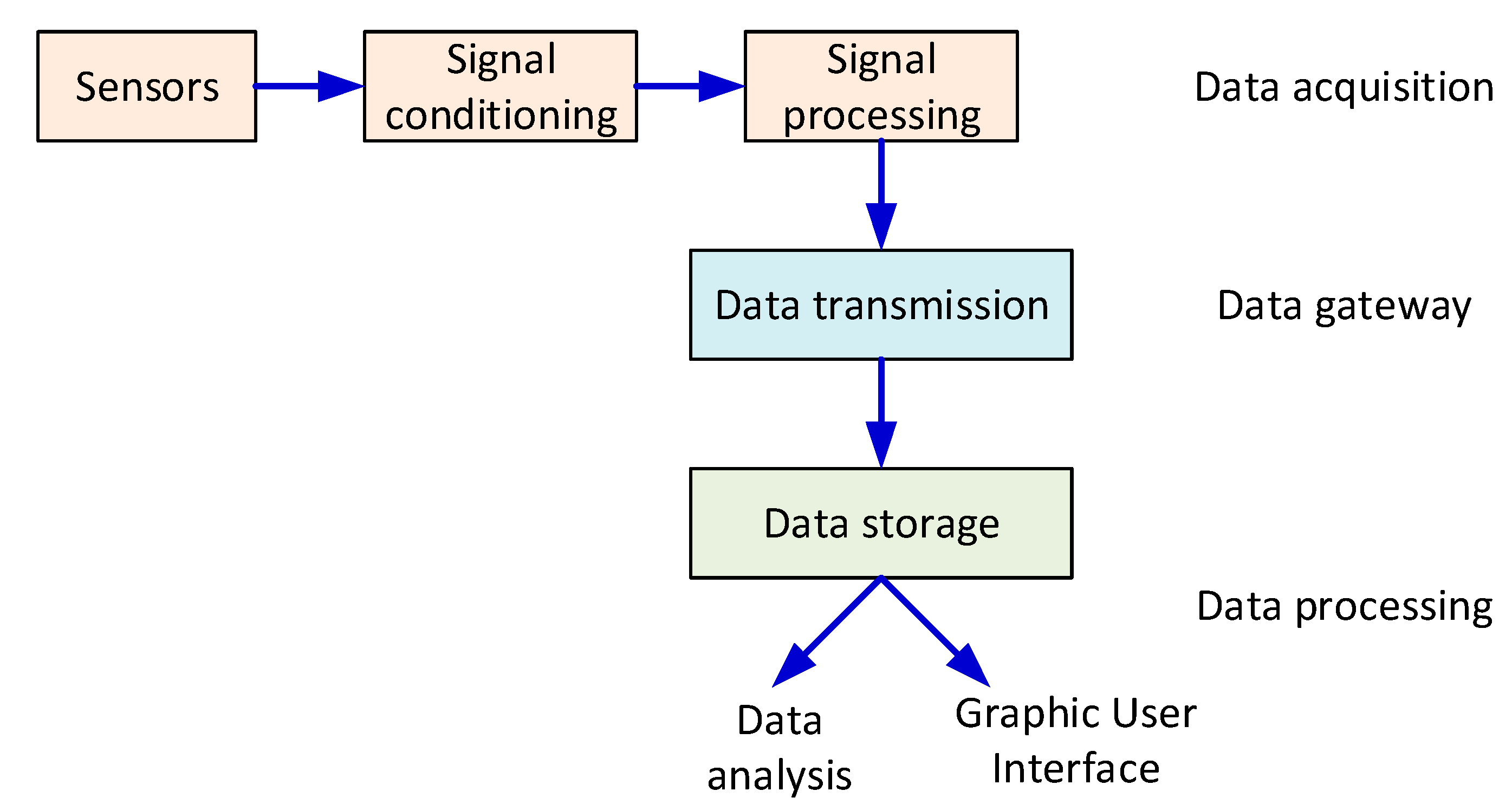
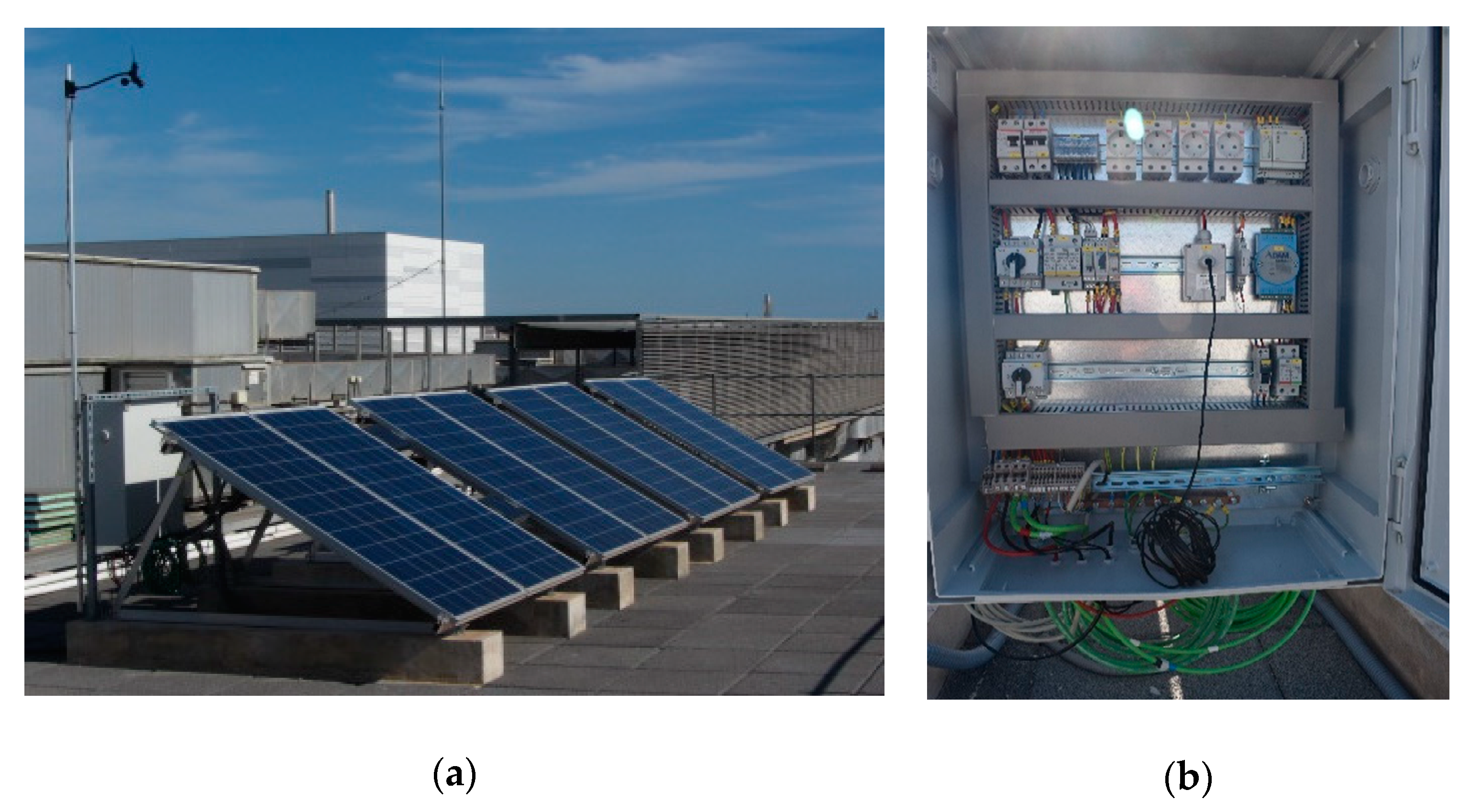
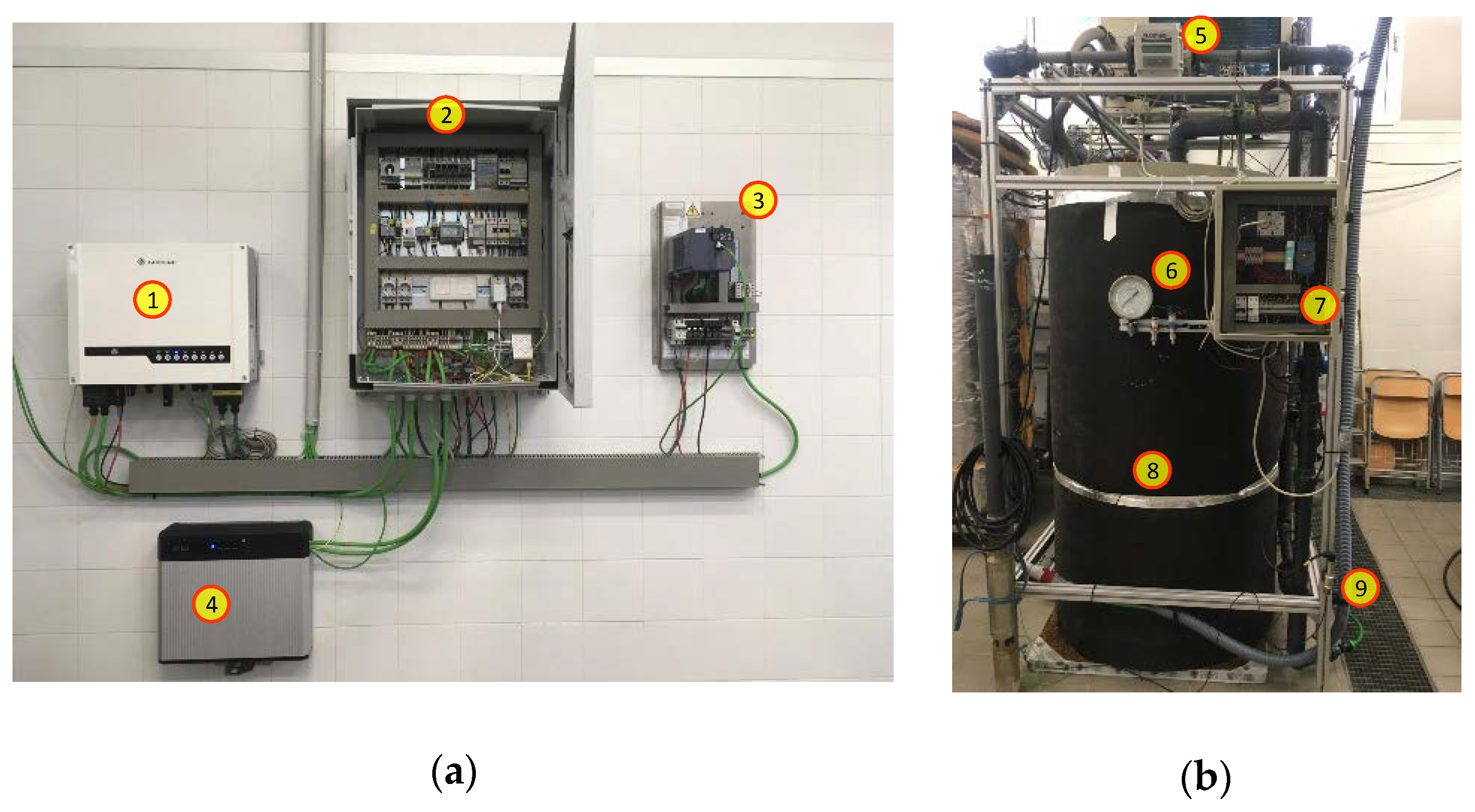
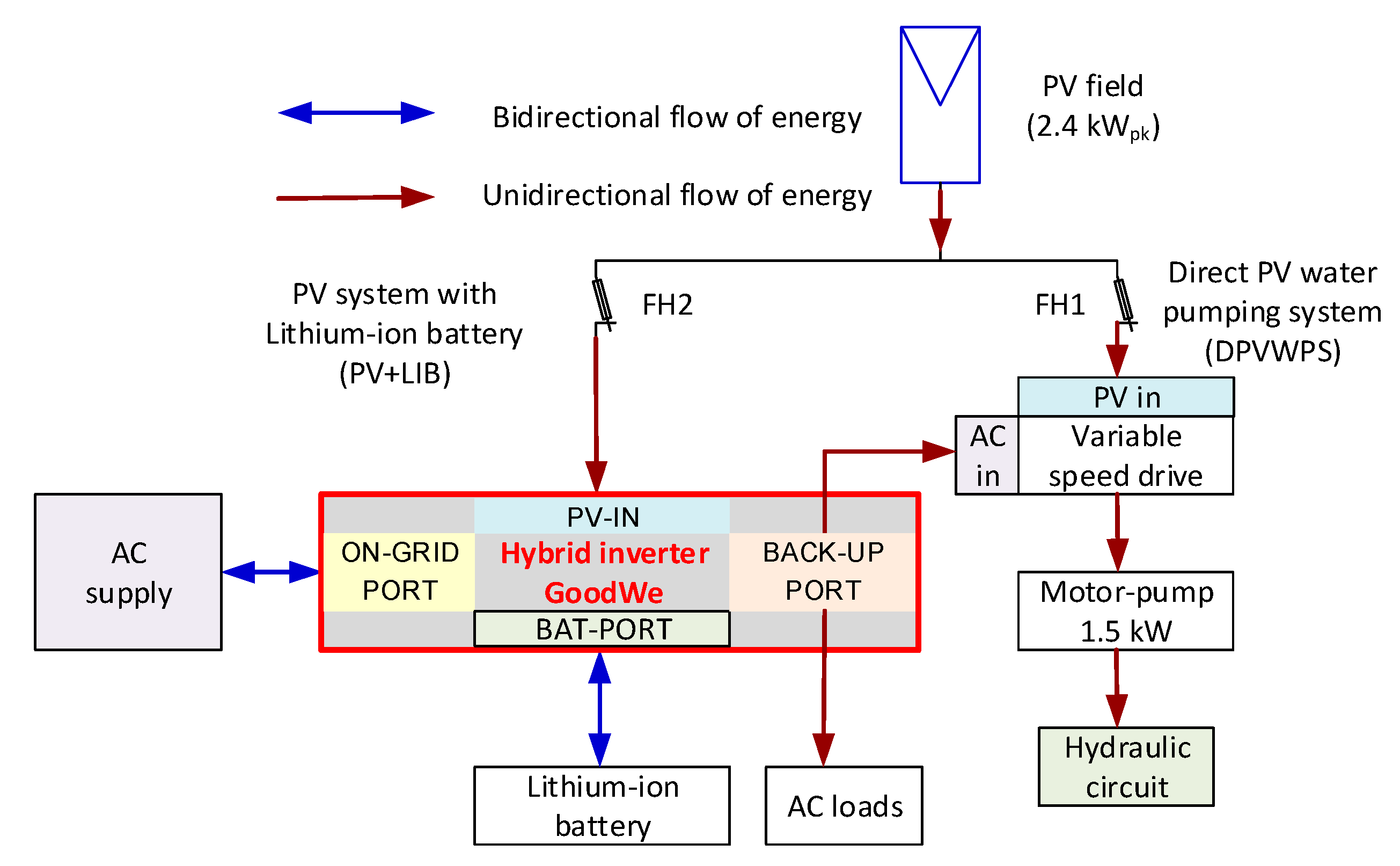
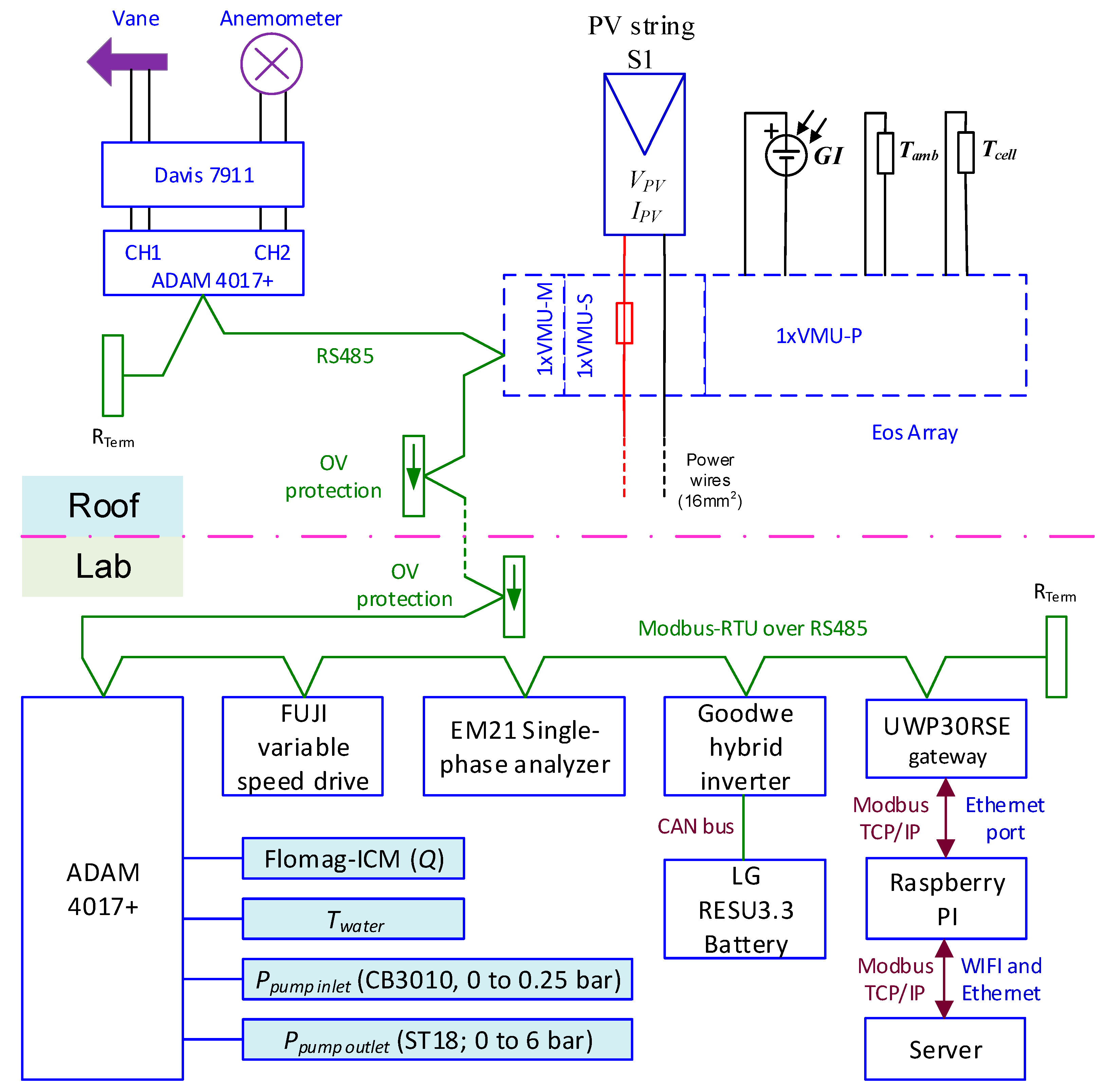
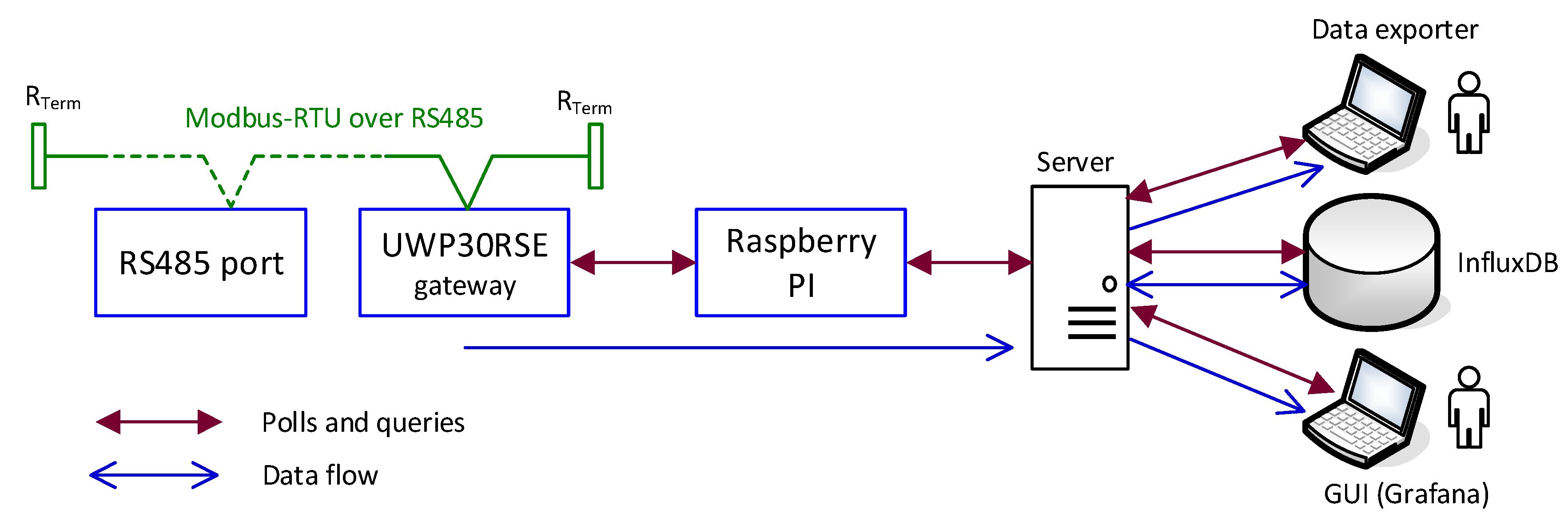
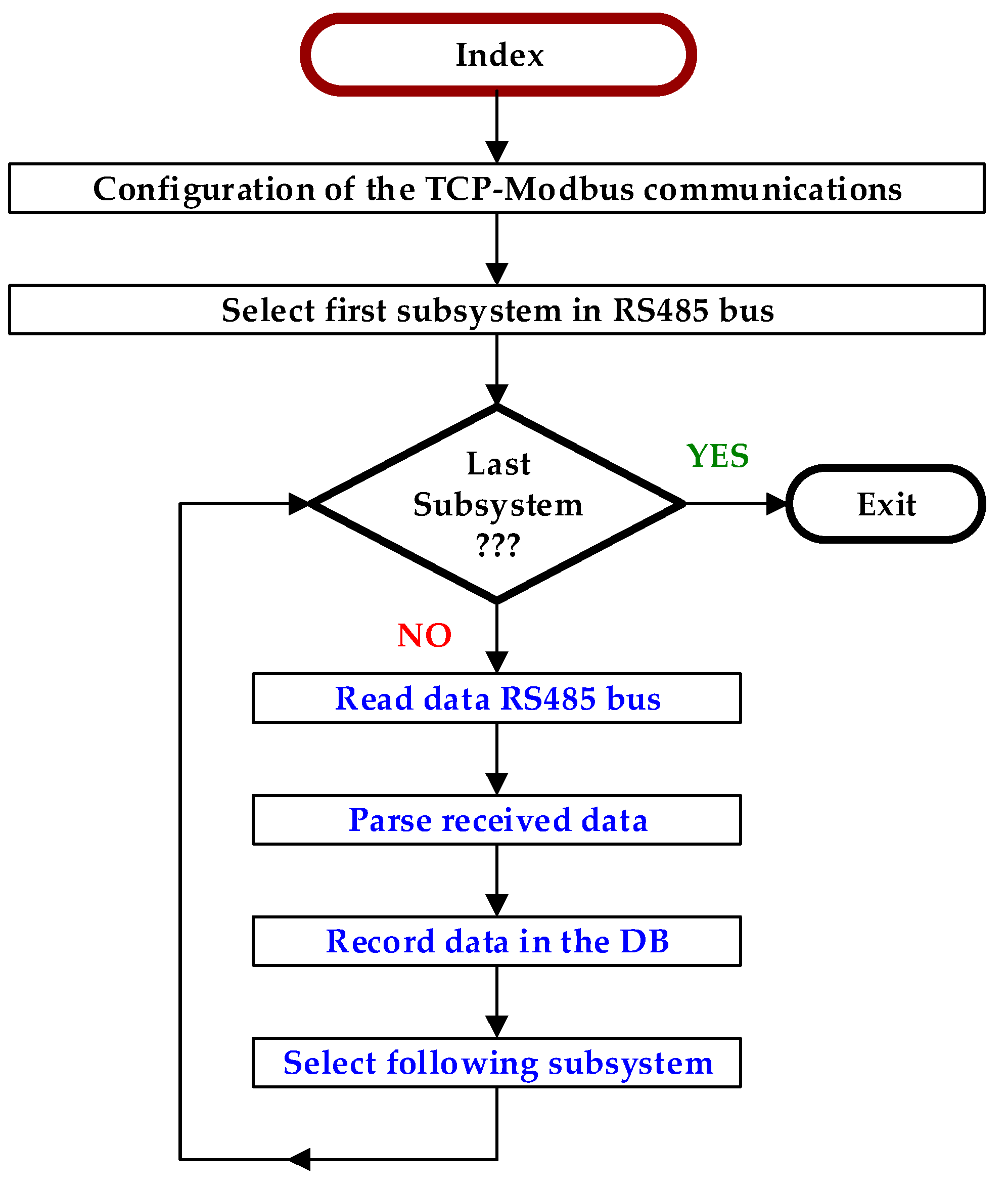
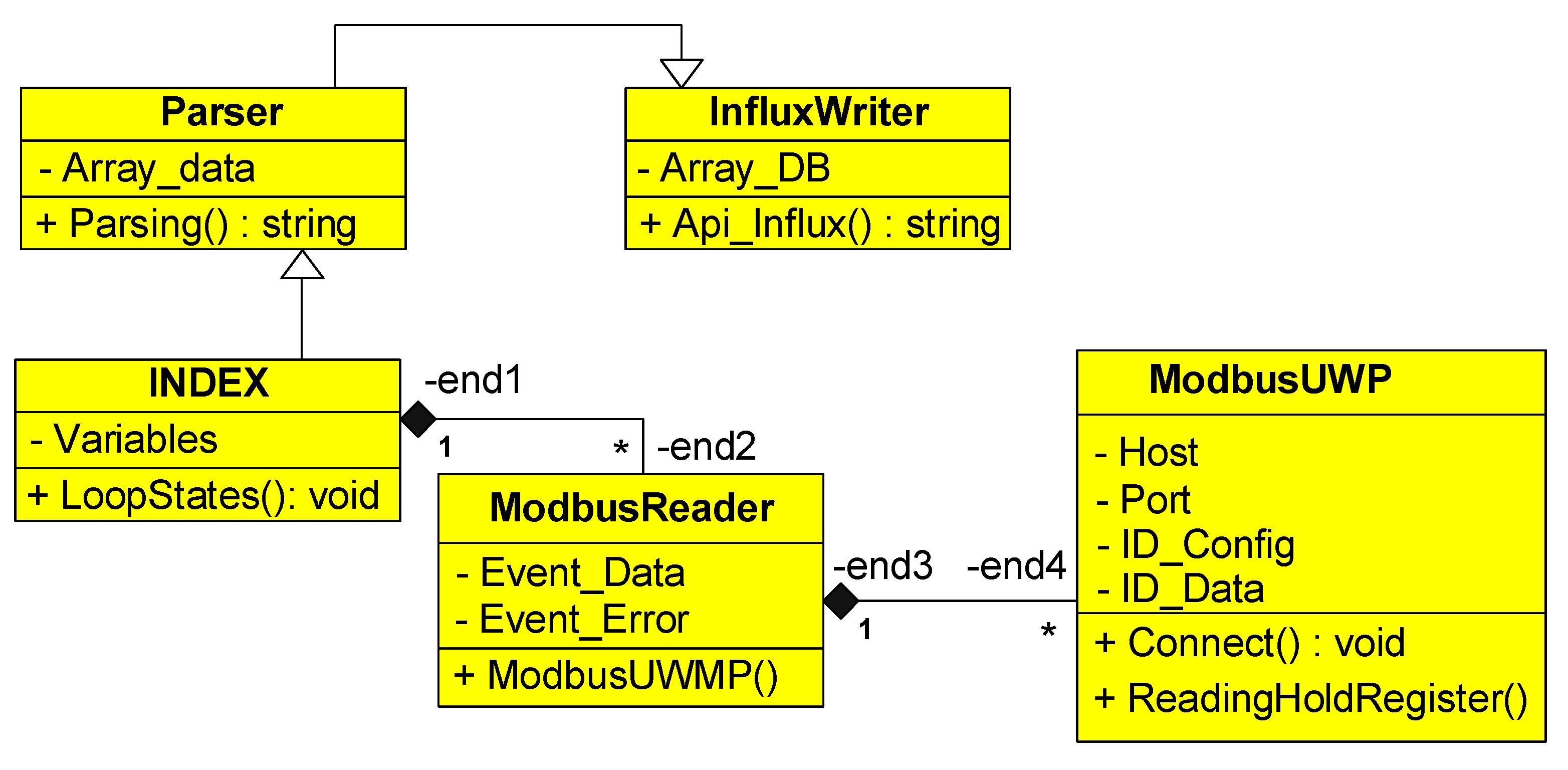
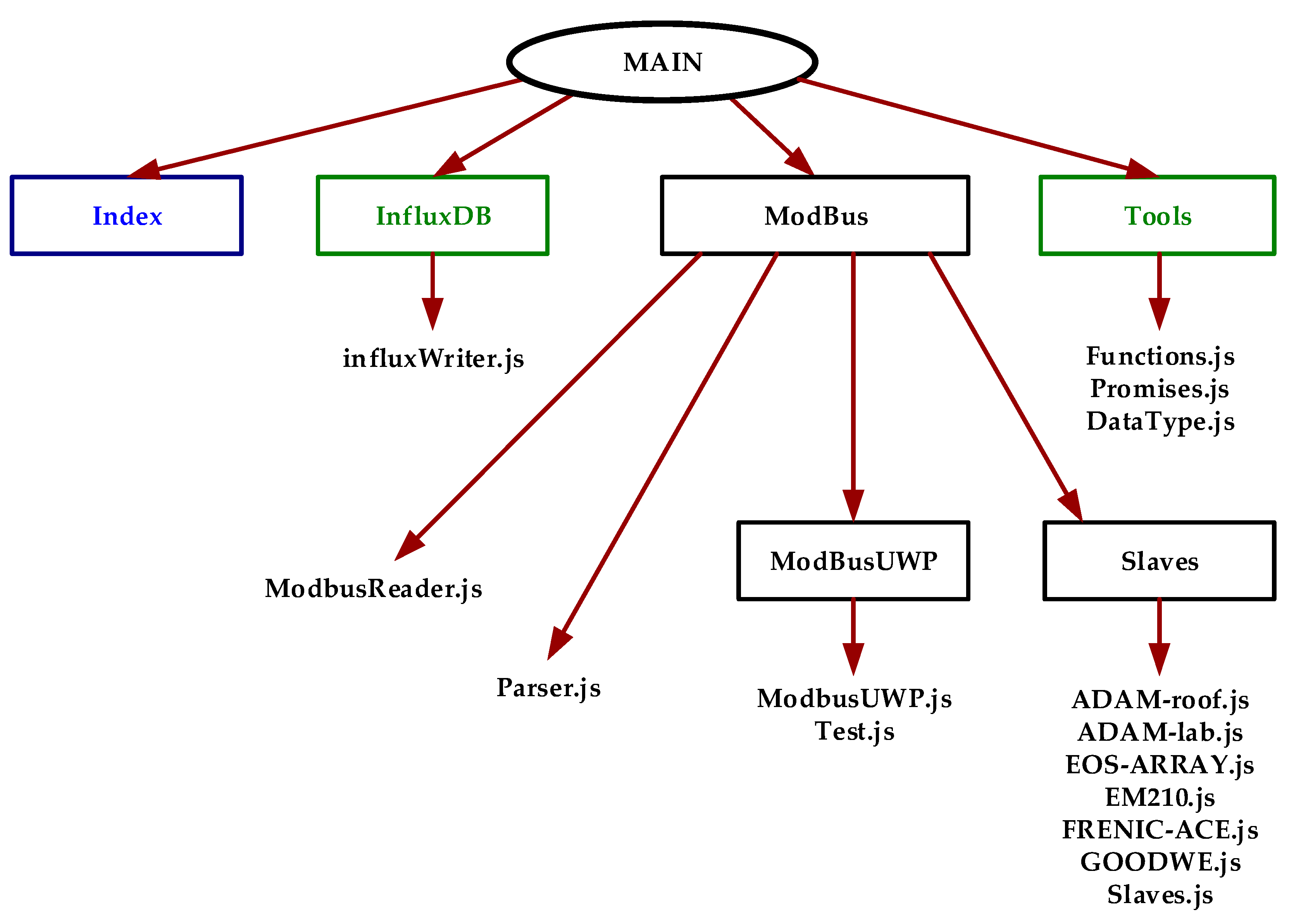
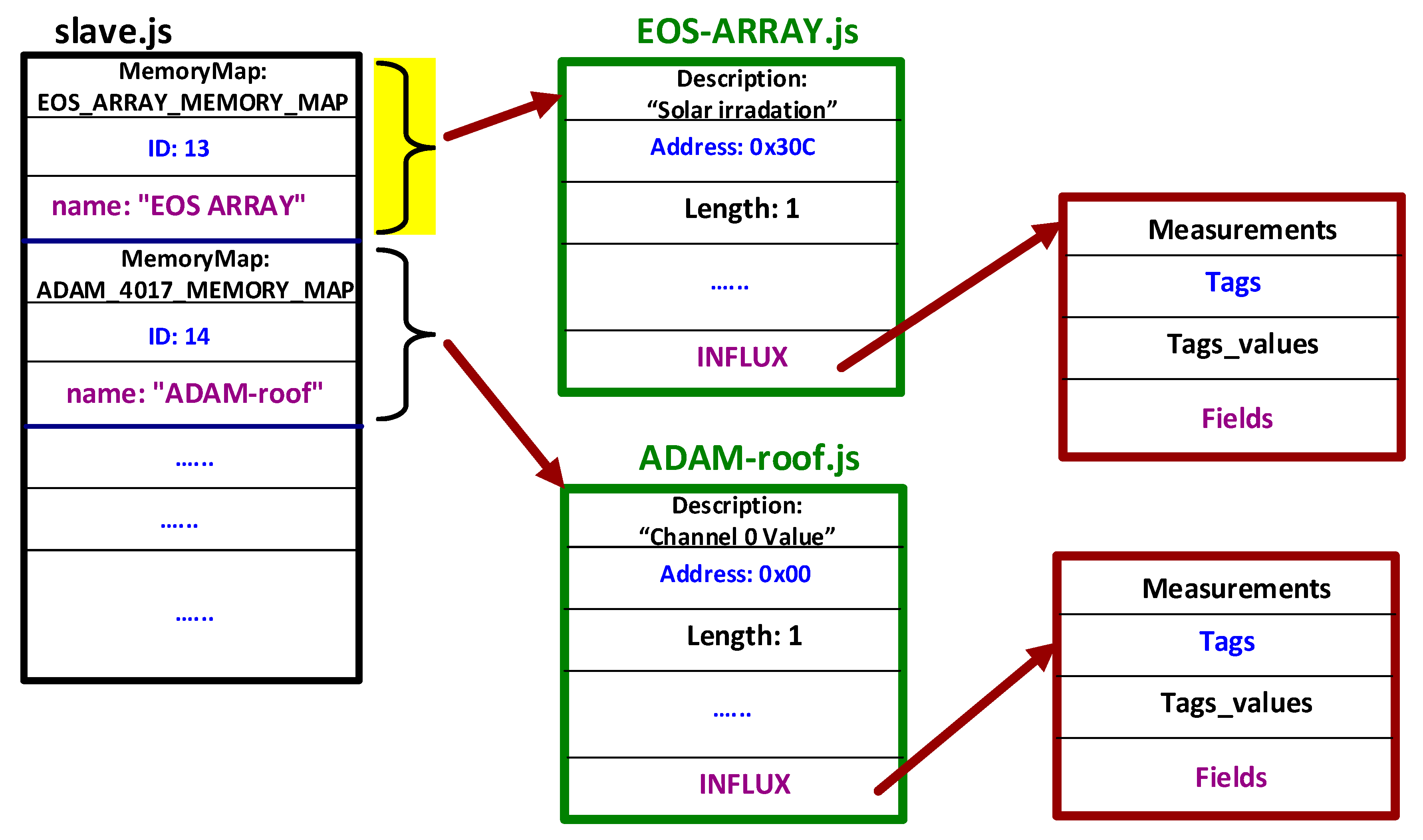
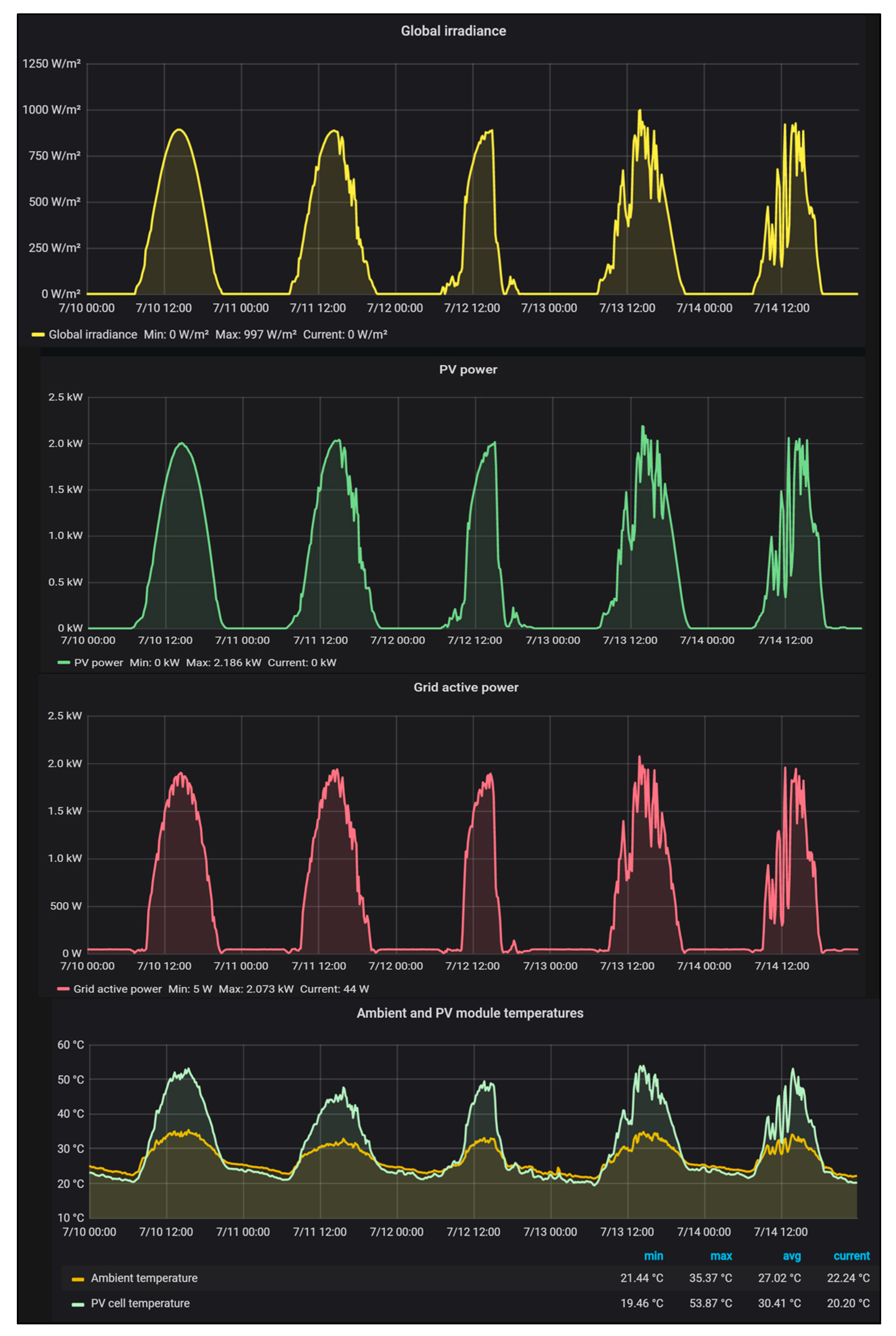
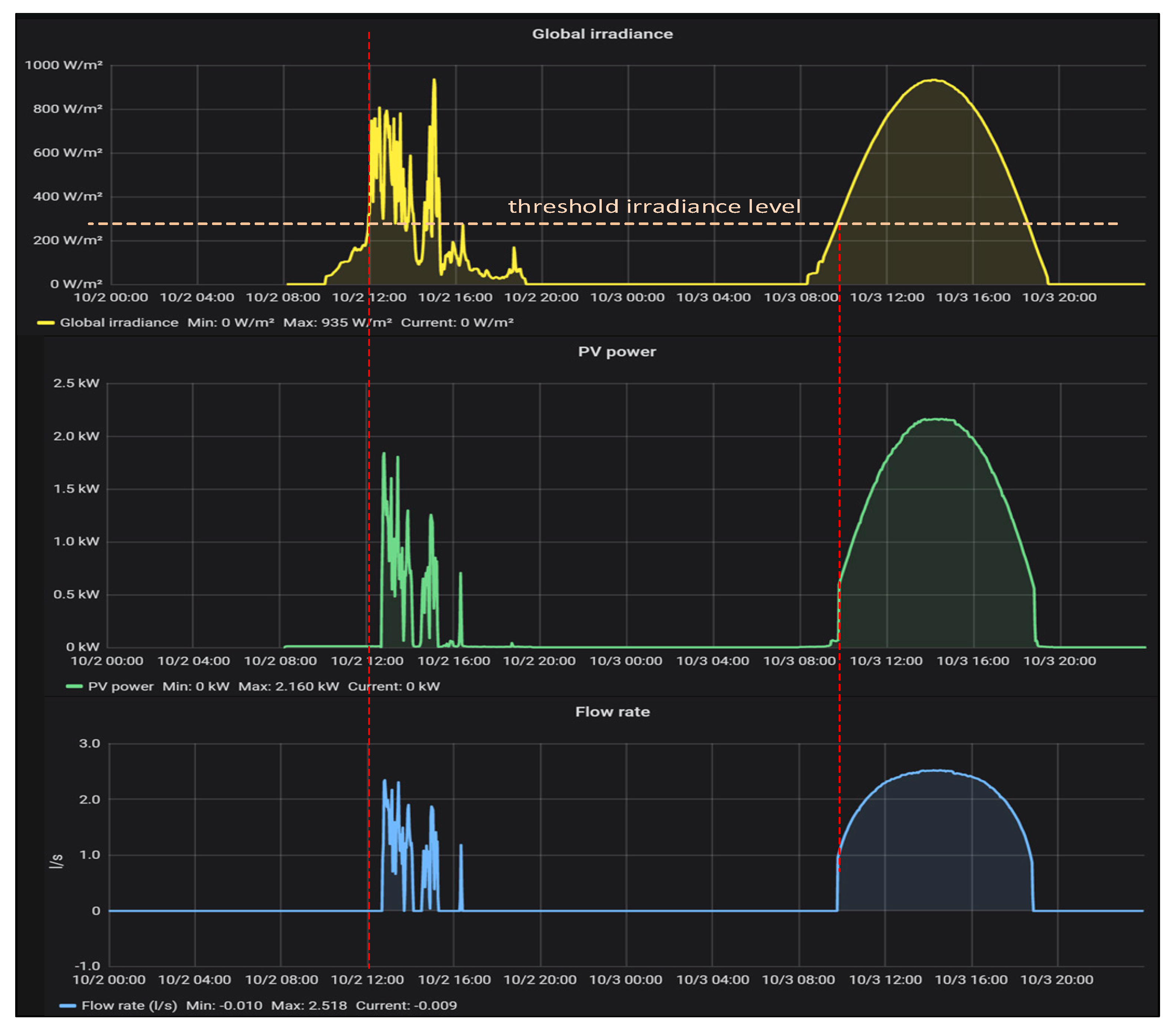
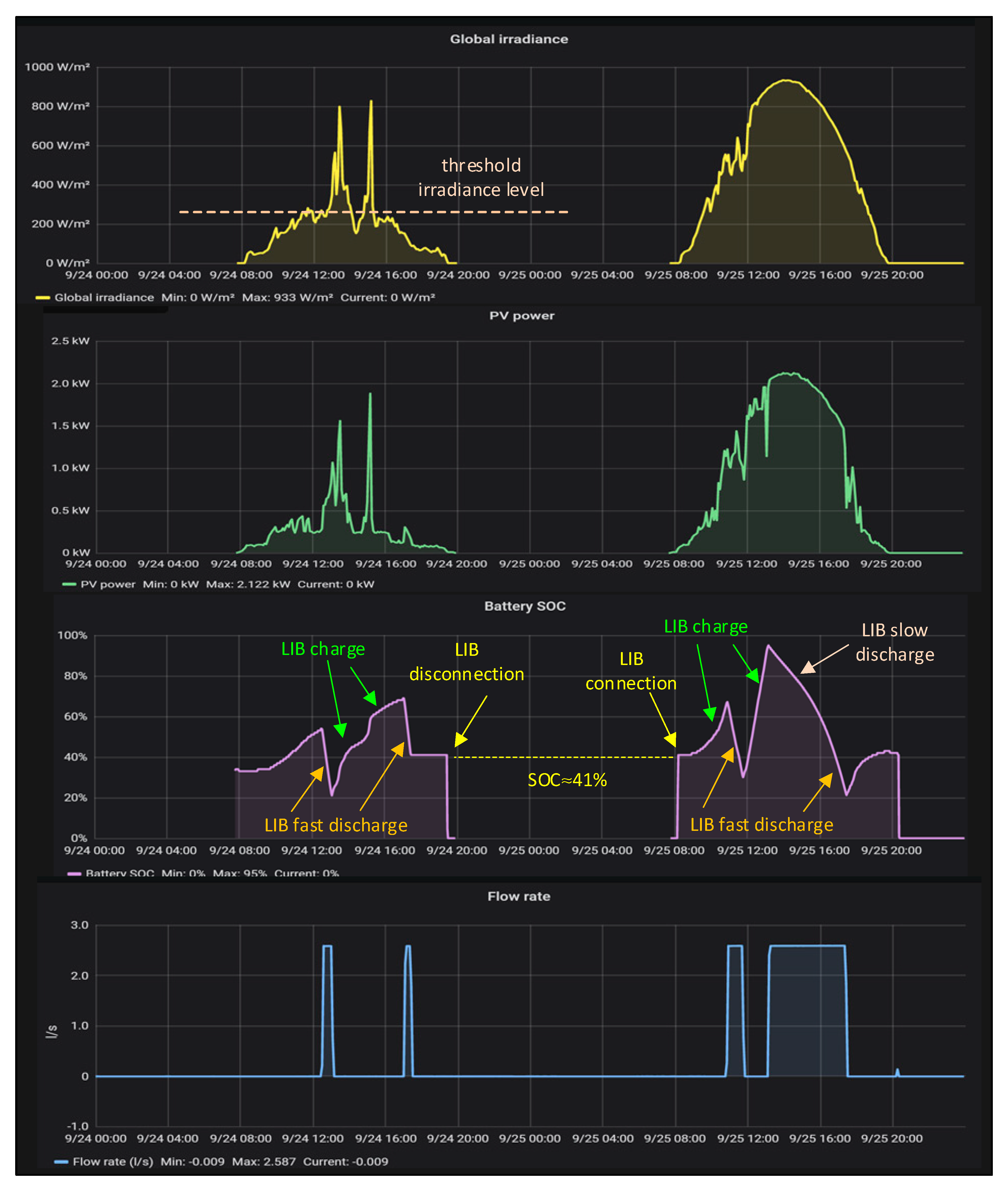
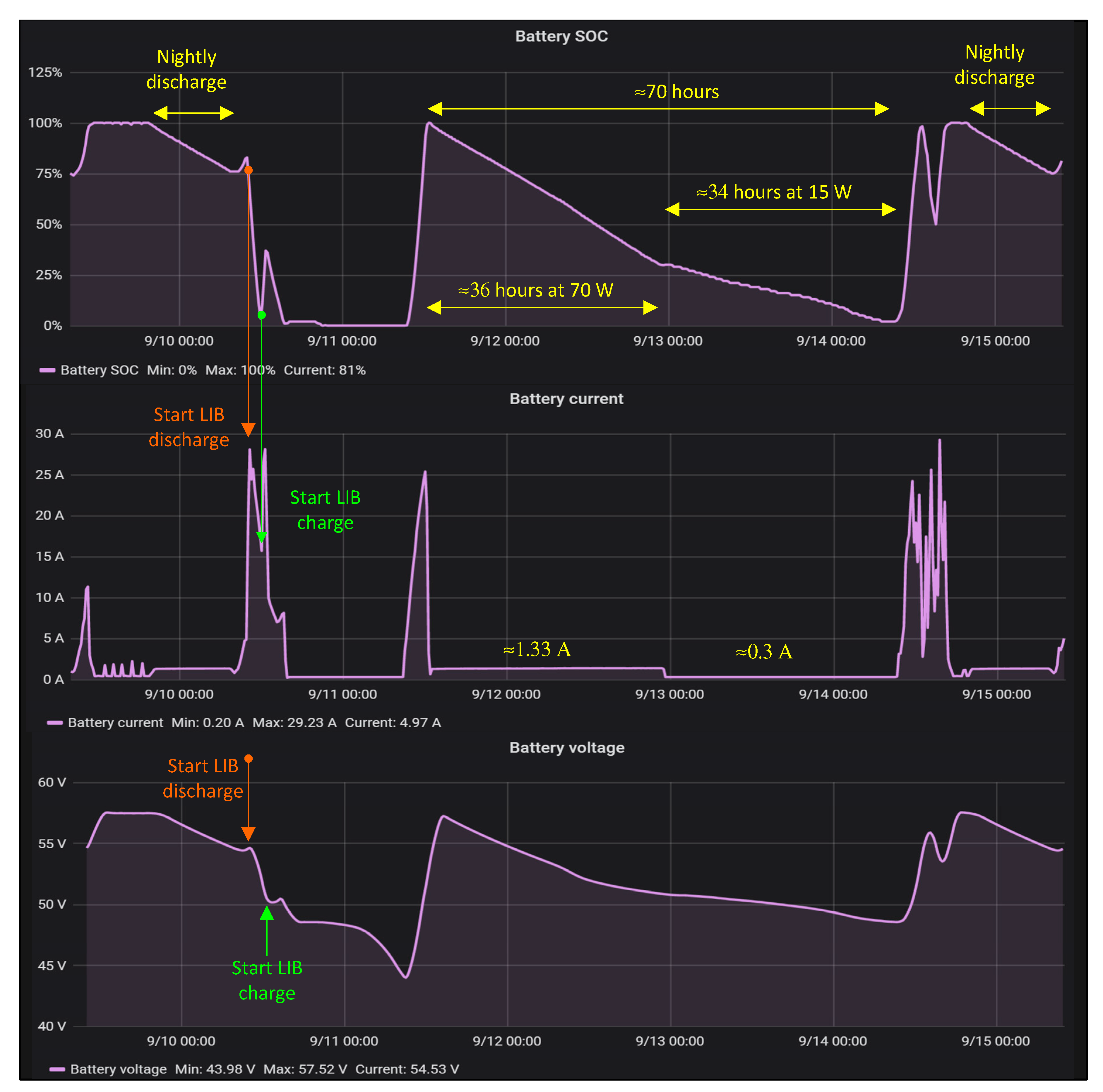

| Open circuit voltage (VOC) | 363.2 V |
| Voltage at maximum power point (VMPP) | 293.6 V |
| Short-circuit current (ISC) | 8.8 A |
| Current at the maximum power point (IMPP) | 8.3 A |
| Power at the maximum power point (PMPP) | 2440 Wpk |
| Eos Array | Goodwe Inverter + LG Battery | Fuji VSD | EM21072 Network Analyzer |
|---|---|---|---|
| GI | Voltages: VPV, VBat, Vgrid, Vload | Input power | Vgrid |
| Tamb | Currents: IPV, IBat, Igrid, Iload | DC bus voltage | Igrid |
| Tcell | Powers: PPV, PBat, Pgrid, Pload | Output voltage | Pgrid, Qgrid, Sgrid, |
| VPV | Energies: EPV, EBat, Egrid, Eload | Output current | Egrid |
| IPV | Frequencies: fgrid, fload | Output frequency | fgrid |
| PPV | Battery: SOC, SOH, BMS pack temperature, etc. | Heatsink temperature | THD |
| EPV | Status: meter, BMS | Water level sensors | PF |
| Power module status | Error message, BMS error code |
Publisher’s Note: MDPI stays neutral with regard to jurisdictional claims in published maps and institutional affiliations. |
© 2020 by the authors. Licensee MDPI, Basel, Switzerland. This article is an open access article distributed under the terms and conditions of the Creative Commons Attribution (CC BY) license (http://creativecommons.org/licenses/by/4.0/).
Share and Cite
Gimeno-Sales, F.J.; Orts-Grau, S.; Escribá-Aparisi, A.; González-Altozano, P.; Balbastre-Peralta, I.; Martínez-Márquez, C.I.; Gasque, M.; Seguí-Chilet, S. PV Monitoring System for a Water Pumping Scheme with a Lithium-Ion Battery Using Free Open-Source Software and IoT Technologies. Sustainability 2020, 12, 10651. https://doi.org/10.3390/su122410651
Gimeno-Sales FJ, Orts-Grau S, Escribá-Aparisi A, González-Altozano P, Balbastre-Peralta I, Martínez-Márquez CI, Gasque M, Seguí-Chilet S. PV Monitoring System for a Water Pumping Scheme with a Lithium-Ion Battery Using Free Open-Source Software and IoT Technologies. Sustainability. 2020; 12(24):10651. https://doi.org/10.3390/su122410651
Chicago/Turabian StyleGimeno-Sales, Francisco José, Salvador Orts-Grau, Alejandro Escribá-Aparisi, Pablo González-Altozano, Ibán Balbastre-Peralta, Camilo Itzame Martínez-Márquez, María Gasque, and Salvador Seguí-Chilet. 2020. "PV Monitoring System for a Water Pumping Scheme with a Lithium-Ion Battery Using Free Open-Source Software and IoT Technologies" Sustainability 12, no. 24: 10651. https://doi.org/10.3390/su122410651
APA StyleGimeno-Sales, F. J., Orts-Grau, S., Escribá-Aparisi, A., González-Altozano, P., Balbastre-Peralta, I., Martínez-Márquez, C. I., Gasque, M., & Seguí-Chilet, S. (2020). PV Monitoring System for a Water Pumping Scheme with a Lithium-Ion Battery Using Free Open-Source Software and IoT Technologies. Sustainability, 12(24), 10651. https://doi.org/10.3390/su122410651





